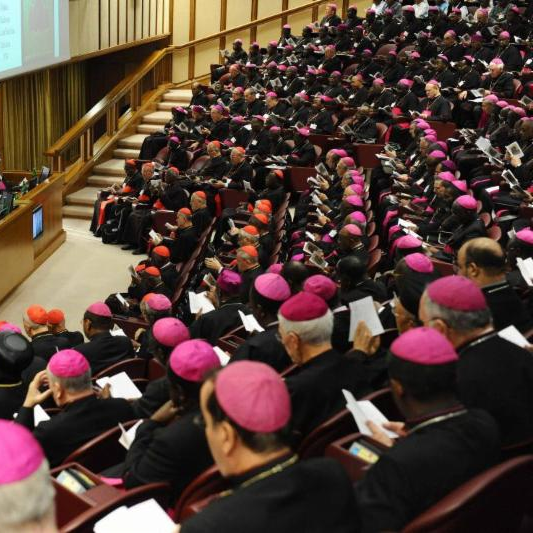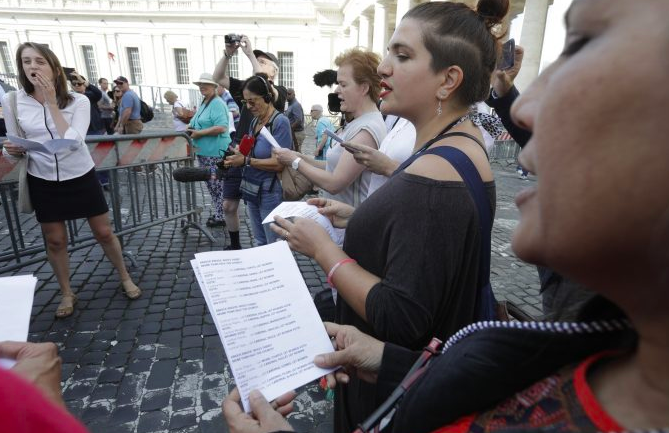Synod on Youth Ends
Christopher Lamb in The Tablet brings a certain British irony to his observations of the synod on youth: “It seems like going on retreat, with a generous helping of church politics thrown in, and a complicated Roman structure.” Yes to all of it. I sense that the lay people and reporters in Rome experienced the month as a very intense experience. It forced them to focus and really listen because the people doing the briefings changed every day. I am most encouraged that the young delegates and others joined the bishops in talking about what their small group sessions were like, as well as about the short speeches made to the whole synod.

Maybe I have too much faith in learning from honest group discussion. Listening may have driven bishops crazy with the diffuse results, but I think exposure is crucial to change. And my two friends reporting for most of the synod feel a decent document came out of it. The big debate now is whether Francis will adopt it as a papal document. The bishop delegates (and the 2 men heads of religious communities) vote section by section; every one was approved, though there were nearly 400 amendments discussed from the floor. Wish you had been there? Anyway.
Kate McElwee of WOC was there every day despite being attacked by police as she led the WOC witness on the streets at the beginning of the synod and the VOTES FOR WOMEN petition (9,000 strong!) during it. I’d characterize her press release at the end as both measured AND fiery.
While the final document fails to mention women’s ordination to priesthood or the diaconate, it suggests that women have been excluded from roles even where there is no “ministerial responsibility.” Separating ordination from decision-making roles would greatly help the Church heal from the sins of clericalism and misogyny.
However, a “duty of justice” must also confront the denial of the institutional Church to recognize many women’s call to priesthood. This discrimination deprives our Church of women’s gifts and preserves a patriarchal culture that subordinates and oppresses those outside of the clerical caste.
See what I mean? The first is a subtle but real step forward in our demand for equality; the second is the giant step we have been pursuing all along.
Frank DeBernardo summarizes what he learned in Bondings 2.0, the blog of New Ways Ministry. While he finds the bishops’ understanding of sexuality more physical than relational, at least they were willing to engage in an open discussion of LGBTQ issues (though not willing to call them that in the final document).
Deb Rose-Milavec of FutureChurch is happy with the synod now that it’s all over. Her final post from Rome includes paragraphs 13, 55, and 148 about women. “Domination, exclusion, and discrimination” should not be a result of “the specific sensibilities” of men and women, with a lot of Genesis quotes about “equal partners” is in 13. “The absence of the female voice and gaze impoverishes the Church’s debate and the path” is in 55. “It is a duty of justice” to have women in “ecclesial bodies at all levels … while respecting the role of the ordained ministry” is in 148. Deb continues:
This final paragraph is the most exciting. It acknowledges women’s participation as disciples of Jesus; the critical work of our foremothers in faith; and the notion that there is an aspect of justice that has been missing within the church.
And at least there is no call for a new theology of women only, just calls to further elaborate the stealth anthropology lurking under most discussions. It’s not literally “the old constraining language of complementarity” which Deb finds, even as she acknowledges that “it is a bit more balanced by the language of justice for women.”
Deb’s reports are the most detailed all through the synod. On her return home, this was her assessment:
Pope Francis exhibits genius — a man on a mission from God. He chose young adults as the topic and the primary voices in piloting this new form of governance. It would be hard, if not impossible, to corral and ostracize their voices as bishops have handily done to other Catholic populations. In the end, young adults spoke boldly about what the church needed while capturing and enlivening the hearts of bishops who had long ago grown distant.
Daily, we heard from prelates that this was “the best” synod they had ever experienced. Young adults served as the voice of the Holy Spirit, penetrating hearts — engendering joy. And along the way, with Francis and his allies, young adults helped create more space for women, LGBT Catholics, victims of clergy sex abuse, while making the idea of a synodal church more appealing (at least harder to say “no” to) to those who had reservations.
Deb is referring to what most other commentators wrote about at the end: the synod process itself. I could go on about it, but I won’t. Nicholas Seneze writes about implementing the synod at the local level. Robert Mickens considers whether the Bishops are with the Pope or just missing the way he’s restructuring the synod process. Michael Sean Winters quotes Cardinal Blaise Cupich: “[T]hese young people — and us bishops too!” and says himself, “There it is. Synodality. Everyone walking together.” That’s a lovely way of explaining the term if you don’t look in the Catholic dictionary. Not quite everyone. I am reminded that, when John Paul II proclaimed in the apostolic letter Ordinatio Sacerdotalis that women could not be ordained, people started debating infallibility, not ordination. So now they are debating “synodality.” Will youth be lost in the look inward to structure?
Seneze notes that women’s ordination was “overcome” by the other debates about women in the synod. Judy Heffernan wondered at mass Sunday if at least now we can discuss women priests – the point of that 1994 document. But who needs permission?
After so many years, it is terrific that our Votes for Women resistance had so much coverage; and ordination is always discussed as part of it. I heard it on NPR: there were articles each in the NY Times, Reuters, and NCR. My only quibble is that the first two used “suffragettes.” We replaced that with “suffragists” when I was in graduate school in the 1980s. Our movements are real movements, not to be trivialized, and NCR does not do that. Josh McElwee summarizes the final document if you want the whole thing, which is still in Italian on the Vatican web site.

Members of the women’s ordination conference stage a ‘singing’ protest on the occasion of the opening of synod, at the Vatican, Wednesday, Oct. 3, 2018. (Credit: AP Photo/Gregorio Borgia.)

3 Responses
The “stealth anthropology lurking under most discussions” is patriarchal gender ideology, aka the sex/gender binary. The fundamental issue is that deconstructing the patriarchal sex/gender binary also deconstructs the exclusively male priesthood, because the body is a sacrament of the person but is not the entire person; and the priesthood of Christ is PERSONAL, not just male (cf. CCC 1548). As long as the patriarchal sex/gender binary is not replaced by a less ideological and more realistic human anthropology, the ordination of women will be resisted and any initiative to enhance the ministerial role of women will be a form of window dressing, because ministerial authority in the church is transmitted via apostolic succession.
Regina, this is terrific. Thanks so much.
Thanks for giving us all a brief, clear summary of the youth synod and Synodality. That term reminds me of what always seemed to be a female organization in the old church: the sodality. But the idea that bishops were listening to the young adults is truly new! THANKS for renewing hope.